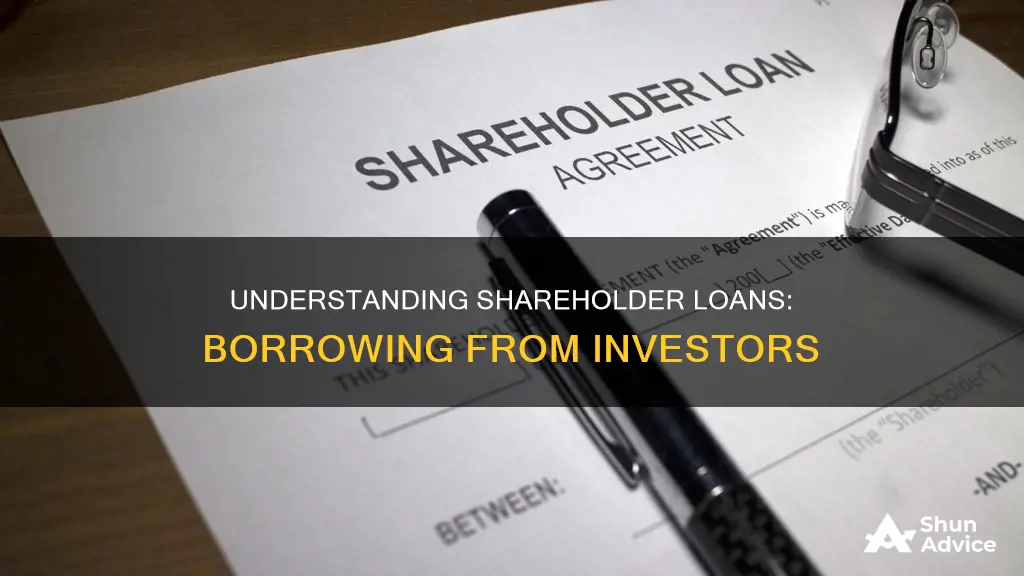
A shareholder loan is a form of financing that blends debt and equity, often structured with a paid-in-kind (PIK) interest component. It is a financial agreement between a shareholder and a company, where the shareholder acts as a creditor and the company as a debtor. Shareholder loans are commonly used by startups or young companies with positive cash flows that require additional funding for operations, projects, or expansion. These loans can be beneficial for tax planning and deferral, as they allow shareholders to borrow from the company and defer personal income taxes. Shareholder loans can also provide capital for investment opportunities, improve liquidity, and offer lower interest rates compared to traditional loans. However, it is important to carefully manage shareholder loans to avoid costly tax mistakes and ensure compliance with regulations.
What You'll Learn
- Shareholder loans are a form of debt-like financing provided by shareholders
- Shareholder loans can be classified as either equity or debt
- Shareholder loans can be used to fund personal expenses
- Shareholder loans can be used to fund investment opportunities
- Shareholder loans can be used to fund business operations

Shareholder loans are a form of debt-like financing provided by shareholders
Shareholder loans can be structured in various ways, but they typically involve a financial agreement between a shareholder and the company. When a shareholder lends money to a company, they become a creditor, and the company becomes the debtor. The loan agreement outlines the details of the loan, including the loan amount, interest rate, monthly payments, and duration. Shareholder loans are usually structured with a fixed paid-in-kind (PIK) interest rate, which accrues towards the ending principal of the loan rather than being paid in cash.
Shareholder loans can have tax implications for both the corporation and the shareholder. For corporations, interest paid on a shareholder loan is generally tax-deductible, similar to a traditional loan. However, there may be limitations, such as the loan being treated as debt rather than equity for tax purposes. Shareholders who borrow money from the company may need to report it as personal taxable income if the loan is not repaid within a specific timeframe, typically within a year.
Shareholder loans can be an essential tool for financial planning and tax strategy. They offer lower interest rates than traditional loans, more flexibility, and control for the shareholder. Additionally, shareholder loans can provide capital for investment opportunities, improve liquidity, and help manage cash flow. However, it is important to carefully consider the potential tax consequences and seek professional advice to avoid costly mistakes.
Shareholder loans can also impact a corporation's negotiating power during mergers and acquisitions. A high number of liabilities, including shareholder loans, can weaken the negotiating position of a target company while benefiting an acquiring company. Therefore, it is crucial for acquiring companies to conduct thorough due diligence and carefully assess the financial commitments they are taking on.
Contingency Loans: What Are They and How Do They Work?
You may want to see also

Shareholder loans can be classified as either equity or debt
A shareholder loan is a form of specialised financing that blends debt and equity, usually structured with a paid-in-kind (PIK) interest component. The term "shareholder loan" is typically used when discussing a private company. A shareholder loan sits between debt and common equity in the capital structure.
An advance may be classified as equity if it was made to save the business from imminent failure and no attempts at repayment have been made. If there is no schedule for repayment and no formula to determine interest payable, it is more consistent with equity than debt. Additionally, if the advance is subordinate to bank debt and other creditors, it is more likely to qualify as equity.
On the other hand, an advance is more likely to be treated as debt if there is a written agreement with reasonable interest, a fixed maturity date, a history of periodic loan repayments, and collateral. Consistently treating an advance as debt or equity on tax returns can also provide insight into its proper classification.
EZ Cash Loan: Quick, Easy, and Secure Lending
You may want to see also

Shareholder loans can be used to fund personal expenses
A shareholder loan is a form of specialised financing that blends debt and equity, often structured with a PIK (paid-in-kind) interest component. Shareholder loans are often referred to as preferred stock, as they sit between debt and common equity in the capital structure. The term "shareholder loan" is usually used in the context of private companies rather than publicly traded companies. Shareholders can provide loans to the business (loans from shareholders), or they can borrow money from the business (loans to shareholders).
Loans to shareholders allow shareholders to borrow money from the business and use it to fund their personal expenses. This helps shareholders take out a personal loan from the company instead of a bank or other financial institution, while the company benefits from earning interest on the loan. Before transferring funds, a formal written loan agreement must be drafted, outlining the loan as an "arms-length" transaction between the shareholder and the corporation as two separate parties. The loan agreement should include the loan amount, interest rate, monthly payments, and loan duration.
Shareholders who borrow money from the company to fund their personal expenses must record these transactions accurately in their books. Personal expenses are typically recorded as a reduction in the shareholder loan account, indicating that the shareholder owes the company funds and is required to repay the loan. To avoid tax issues, it is important to keep a close eye on the shareholder loan account. Personal withdrawals, contributions, and expense payments should be accurately tracked to distinguish between debit and credit balances.
If a shareholder uses their personal funds to pay for business expenses, it is considered an owner contribution, and the company will need to reimburse the shareholder. This transaction may be recorded as a "due to shareholder" entry in the company's books, indicating that the company owes the shareholder reimbursement for the funds advanced. It is important to note that personal expenses are generally not deductible as business expenses. However, any interest paid on a shareholder loan is typically tax-deductible, provided it is supported by the loan agreement and amortization table.
Understanding DSCR Loans in Texas: A Guide
You may want to see also

Shareholder loans can be used to fund investment opportunities
A shareholder loan is a form of financing that blends debt and equity, often with a PIK (paid-in-kind) interest component. It is typically used by private companies, where a financial sponsor or specialty lender provides financing. Shareholder loans are often used to fund investment opportunities, providing capital for ventures such as real estate, stocks, or business expansions.
Shareholder loans can be an attractive option for companies that need additional funding but want to avoid the higher interest rates and lack of control associated with traditional loans. They offer more flexibility and control, and in some cases, lower interest rates. This can be especially beneficial for startups or young companies that may not yet qualify for bank loans but require debt to create a tax shield. Shareholder loans can also be used to fund day-to-day operations or cover expenses until the company becomes profitable.
When a shareholder lends money to the company, it is important to document the transaction properly. A formal written loan agreement is necessary, outlining the loan amount, interest rate, monthly payments, and duration. The loan agreement should treat the transaction as "arms-length," meaning the shareholder and corporation are acting as separate parties and the terms are in line with market rates. Shareholder loans can have tax implications, and proper documentation helps ensure compliance. For example, interest paid on a shareholder loan is tax-deductible for the corporation, while the shareholder must report this interest as income on their personal tax return.
Shareholder loans can be a valuable financial strategy, providing capital for investment opportunities while offering potential tax benefits and maintaining control within the company. However, it is important to carefully consider the terms and potential risks, such as the impact on the company's negotiating power and the possibility of double taxation if loans are not repaid promptly.
Lending Club Weekend Loan Approvals: What You Need to Know
You may want to see also

Shareholder loans can be used to fund business operations
A shareholder loan is a debt-like form of financing provided by shareholders. It is a financial agreement between a shareholder and a company, where the shareholder acts as a creditor and the company as a debtor. Shareholder loans are often used to fund business operations, providing additional capital for projects, day-to-day operations, or expansion.
Shareholder loans can be particularly beneficial for startups or young companies that may not yet have access to traditional bank loans but require debt to create a tax shield. In such cases, shareholders can lend funds to the company to cover expenses and support its operations. This type of financing can also be advantageous in terms of tax planning and deferral. By taking out a loan from the corporation, shareholders can defer personal income taxes and reduce their current tax liability.
The interest rates on shareholder loans are typically lower than market rates, and they offer more flexibility and control to the shareholder. These loans are usually structured with a fixed paid-in-kind (PIK) interest rate, where interest accrues towards the ending principal of the loan rather than being paid in cash. This can provide short-term benefits to the company by increasing the original principal and, consequently, the interest owed over time.
To ensure compliance and avoid tax issues, it is crucial to have a formal written loan agreement in place before transferring funds. This agreement should outline the loan amount, interest rate, monthly payments, and repayment duration. The loan should be treated as an "arms-length" transaction, with the shareholder and corporation acting as separate entities engaging in a market-value transaction. Proper documentation and adherence to the agreed-upon terms are essential to mitigate potential tax complications.
Red Arrow Loans: BBB Accreditation Status Explained
You may want to see also
Frequently asked questions
A shareholder loan is a financial agreement between a shareholder and a company. It is a form of specialised financing that blends debt and equity, often with a PIK (paid-in-kind) interest component.
A shareholder loan can be a loan from a shareholder to a company, or from a company to a shareholder. When a shareholder lends money to a company, the shareholder is the creditor and the company is the debtor. When a company lends money to a shareholder, the shareholder repays the loan within a specific timeframe to avoid it being taxed as personal income.
Shareholder loans can be a valuable financial strategy, offering lower interest rates, more flexibility and control. They can also be used for tax planning and deferral, as well as providing capital for investment opportunities.
Shareholder loans can lead to costly tax mistakes if not managed properly. For corporations, the tax implications are similar to a traditional loan. Any interest paid on a shareholder loan is tax-deductible, but only if it is backed up by a loan agreement and amortisation table. For shareholders, any payments towards the principal are not recorded as personal taxable income, but the interest received must be reported on a tax return.
A capital contribution is when a shareholder invests in the company and receives an increase in equity, usually in the form of shares or stocks. Capital contributions are not taxed, but shareholders may have to pay capital gains tax if they profit from the sale of that equity in the future.







